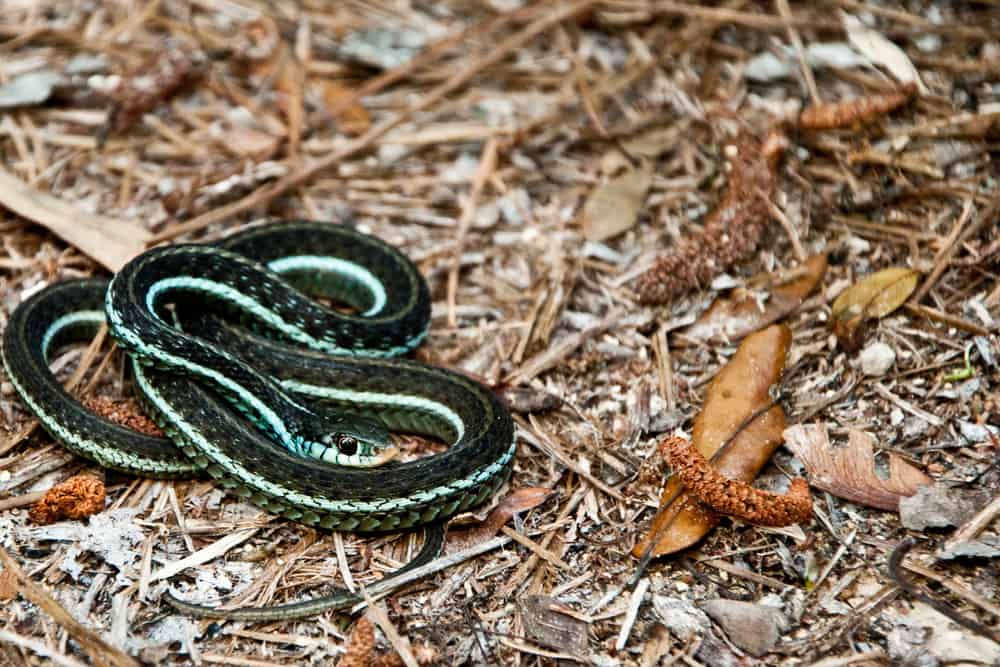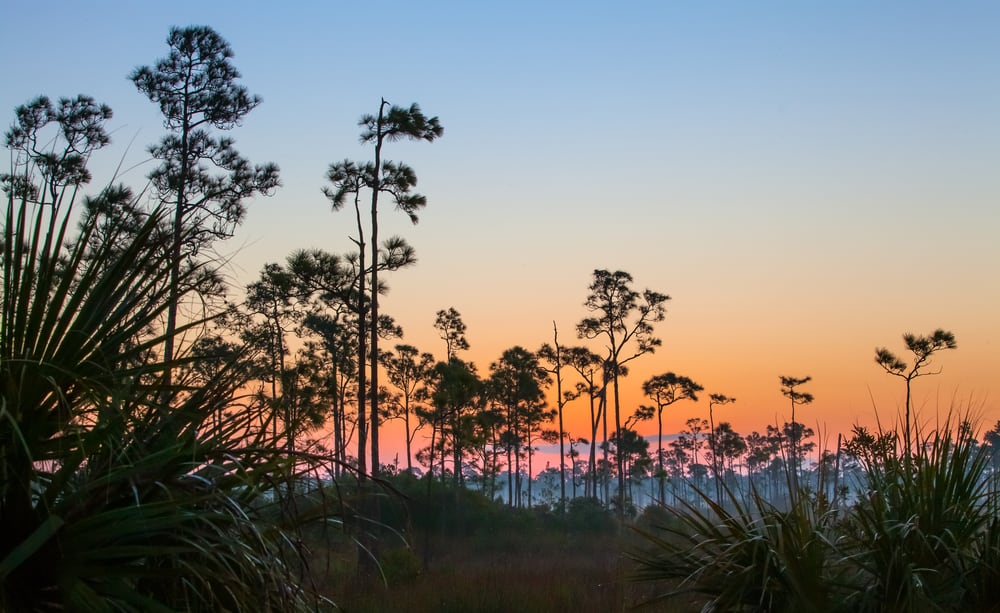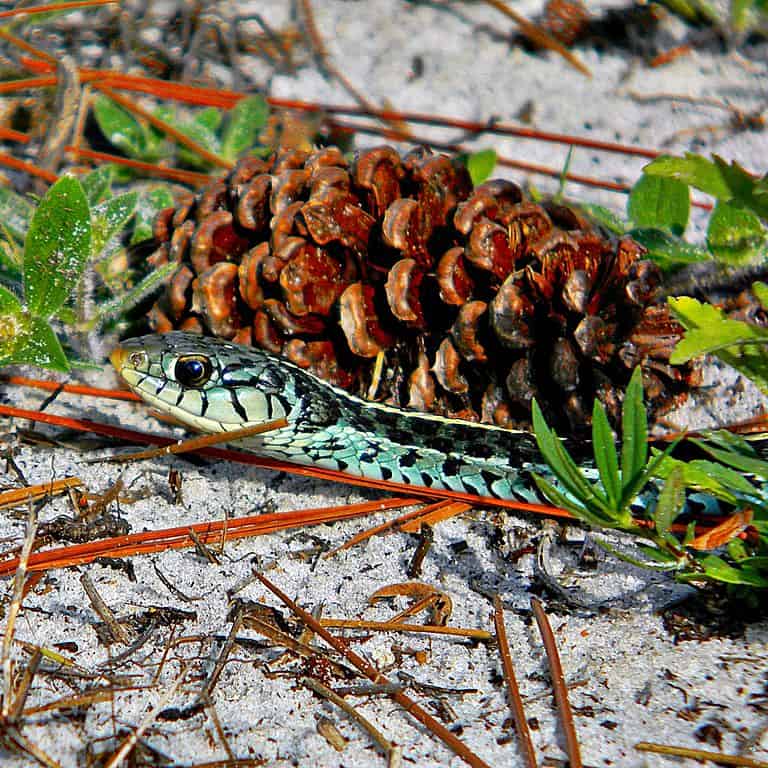The climate in Florida ranges from humid and subtropical in the north, to tropical in the southern parts of the state. This ocean cradled landscape is home to abundant wildlife like alligators, scorpions, black bears, and bobcats. The warm weather is also perfect for cold-blooded snakes. Over 40 snakes are native to the region, including garters! Let’s have a look at garter snakes in Florida. We’ll determine which species live here, how to identify them and where in the state they reside.
Get Familiar with the Garter Snake

The blue-striped garter snake, often called the ‘Florida blue’ is a subspecies of the common garter snake, one of the two species found in the state.
©Jay Ondreicka/Shutterstock.com
Part of the Natricinnae subfamily, garter snakes give birth to live young, as do most others in the group. To be a garter snake, the snake must belong to the genus Thamnophis. This name is derived from the word thamnos, meaning ‘bush or shrub,’ and ophio, for ‘snake.’ There are 35 species of garter snake. Garters are ‘cold-blooded’ ectotherms, like all snakes, whose temperature relies on environmental conditions. In order to regulate their bodies temperature they either absorb or give off heat. In the blazing heat they might retreat to find shady areas of cover. When they need to warm up you might catch them lounging on hot rocks to bask in the warmth of the Florida sun.
As highly opportunistic snakes, garters have adapted to thrive in diverse habitats and eat many different prey types, depending on the ecosystem where they live. You can find them living in forests, marshes, swamps and brush-filled areas where there is plenty of cover. These snakes generally prefer to live near water. It’s not uncommon to find garters at the edges of rivers, streams, ponds and lakes. They’ll venture into residential areas and slither in the garden or in woodpiles, hedges and rocks. Garter snakes’ preferred prey are amphibians like frogs, toads and salamanders, as well as earthworms, mice, small fish, slugs, insects and even small snakes. These snakes grow to be 18 to 48 inches on average, with some species reaching a maximum of 54 inches.
Garter Snakes In Florida

The common garter snake and the eastern ribbon snake are the two garter species that live in the warm, humid environment of Florida.
©jo Crebbin/Shutterstock.com
Garter snakes are at home in the humid Florida climate. While there are many wild spaces for them to explore in the state, they also often thrive in suburban and urban areas. This is partly due to their method of giving live birth, called ovoviviparity. Since they don’t need a safe space to lay eggs they have more flexibility in terms of habitat. You can find them throughout Florida near freshwater at the banks of marshes or swamps, and streams, as well as rivers, canals, ponds and ditches. They live in pinelands, near cypress swamps, forest edges, agricultural areas, urban lots and maybe even your backyard!
Garters are typically solitary and diurnal, coming out in the morning to bask in the sun and to hunt midday. In colder climates, they go into a period of inactivity called brumation in which they tuck themselves in crevices, under rocks or in communal dens to ride out the cold. Florida is a warm, humid state that rarely experiences snow or even frost, so it’s unlikely that they ever have to brumate in this state. They are able to stay warm and active throughout their range throughout the year.
Which Garter Snake Species live in Florida?
There are 2 garter snake species that live in Florida:
- Common Garter Snake (Thamnophis sirtalis)
- Eastern Garter Snake (T. s. sirtalis)
- Blue-striped Garter Snake (T. s. similis)
- Eastern Ribbon Snake (Thamnophis sauritus)
- Blue-striped Ribbon Snake (T. s. nitae)
- Peninsula Ribbon Snake/ Southern Ribbon Snake/ Florida Ribbon Snake (T.s. sackenii)
- Common Ribbon Snake (T. s. sauritus)
Garters are common in the pet trade in Florida. According to the book Herptile Use and Trade in Florida, 3,263 eastern ribbon snakes and 4,030 common garter snakes that originated in the Florida wild were sold as part of the pet trade in the state.
The Common Garter Snake

The blue-striped garter is a striking subspecies of the common garter!
©Bob Peterson from North Palm Beach, Florida / Creative Commons – License
Common garter snakes in Florida often have a blotched and striped body that’s olive-brown to black. Their heads are typically gray, olive or black. Three yellow, green, brown, blue or white stripes usually run the length of their bodies, but they may be faint or absent in some of them. The blotches are seen between the stripes like a checkerboard and may obscure the stripes at times. They have keeled scales (lengthwise ridges). They could almost be mistaken for the venomous pygmy rattlesnake, however they have much thinner bodies and round instead of vertical, cat-like eyes of the venomous Pygmy.
The eastern garter snake and blue-striped garter snake are the two subspecies of the common garter that are found in Florida. Easter garter snakes are found throughout most of mainland Florida and there is one account from the Florida Keys. They may be absent in the Gulf coast region from eastern Wakulla County in the panhandle region, south to Hernando County. The blue-striped subspecies is known as the ‘Florida blue garter’ and they live along the Gulf coast, however some are found outside of this region and into the neighboring state of Georgia.
Eastern Ribbon Snake

Eastern ribbon snakes are slightly more slender than common garters.
©Steve Bower/Shutterstock.com
Adult eastern ribbon snakes in Florida grow to be about 18-26 inches in length and are very slender bodied snakes. Although absent in some individuals, they usually have three lightly colored stripes running the length of their brown, olive, or blueish-black bodies. Their stripes can vary in color but are usually yellow, tan, brown, blue, or whitish-green. These snakes have long and thin tails and a head that is barely distinct from the neck. Like most garters, they have large and prominent eyes, and this species has a distinct white spot in front of each.
The three subspecies recognized in Florida are the blue-striped ribbon snake, the peninsula ribbon snake and the common ribbonsnake. The blue-striped ribbon snake is found along the Gulf coast from eastern Wakulla County to Hernando County. The peninsula ribbon snake lives throughout most of the mainland east of the Apalachicola river. They are found in the Florida Keys, although maybe not in the Middle Keys. The common ribbon snake live in the panhandle area (northwest Florida) west of the Apalachicola river.
Are Garter Snakes Venomous?
For many people, garter snakes are a welcome sight. They contribute to the balance of their ecosystem, are non-aggressive and assist in keeping common pests at bay. Like most snakes, they are incredibly shy and prefer to stay out of sight. But are they venomous? Turns out, they’re actually considered mildly venomous. Their venom is perfect for subduing their prey but it isn’t potent enough to be harmful to humans. If picked up, they may thrash or bite and often secrete a foul-smelling musk as a deterrent. However, they normally will not bite unless disturbed or provoked.
The photo featured at the top of this post is © Jay Ondreicka/Shutterstock.com
Discover the "Monster" Snake 5X Bigger than an Anaconda
Every day A-Z Animals sends out some of the most incredible facts in the world from our free newsletter. Want to discover the 10 most beautiful snakes in the world, a "snake island" where you're never more than 3 feet from danger, or a "monster" snake 5X larger than an anaconda? Then sign up right now and you'll start receiving our daily newsletter absolutely free.
Thank you for reading! Have some feedback for us? Contact the AZ Animals editorial team.






